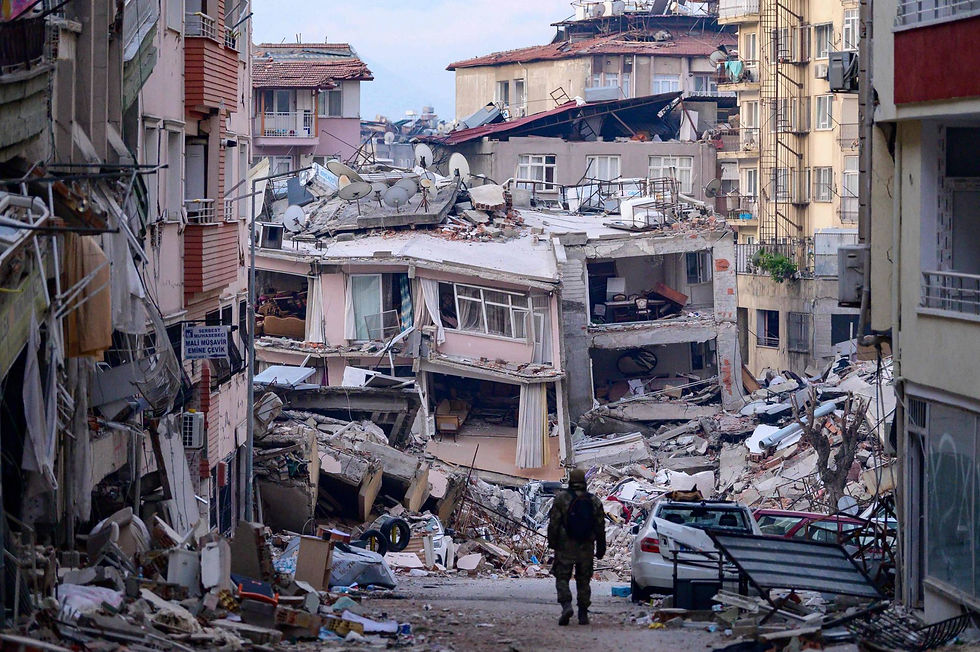How is the Government to Blame in the Turkish-Syria Earthquake?
- Zaha Kırmızıtoprak
- Feb 28, 2023
- 3 min read

On February 6th, 4:17 am, a devastating earthquake of 7.8 magnitude hit the south of Turkey and Northern Syria. 41 thousand deaths which are still rising and hundreds of thousands are still trapped under the rumbles of the buildings in the affected area.
Many countries around the world are sending emergency aid, and rescue workers and donating millions to Turkey and Syria. The world bank has pledged roughly 1.8 billion dollars as the reconstruction cost of the countries will be billions. This is the biggest earthquake to hit Turkey since 1999 in Marmara.
The earthquake has left people in the affected area frightened and hopeless as many loved ones are still yet to be found under the great layer of destruction. It has been 2 weeks since it hit, and people are trapped in freezing temperatures. Alongside terrible injuries, people have to battle through the risk of hypothermia, starvation and dehydration. Being trapped in complete darkness and unable to move or communicate with the outside world would be extremely disorienting and isolating. The longer the victim is trapped, the more difficult it would be to keep hope and faith that they will be rescued. The fear, uncertainty, and pain would be unbearable, and it is truly an experience that no one should have to endure.
Turkey is in the seismic zone. This means that it is an area that is an active earthquake zone. According to David Rothery, a geoscientist at the Open University in Milton Keynes, UK, Turkey is situated on the Anatolian plate, which is located between the North Anatolian Fault and the East Anatolian Fault. Due to the collision of the Arabian tectonic plate, which includes Syria, with the southern edge of Eurasia, Turkey is being pushed towards the west, moving at a rate of approximately 2 centimetres per year along the East Anatolian Fault. Rothery further notes that half of the East Anatolian Fault is presently experiencing seismic activity. The Turkish geologists have been warning the state about the tension along the tectonic plates but they were not taken seriously.
This proves that it is not a surprise that the earthquake happened and the state should have been more prepared to avoid more casualties.
After the 1999 Izmit earthquake the building regulations were so-called tightened. These included strengthening the building codes, retrofitting existing buildings and inspecting buildings. Everyone also expected that in another great disaster, the state would be more organized and would get to the action quicker however all these expectations were not met. The citizens are furious and filled with questions such as: ‘Why are new buildings collapsing like houses of cards?’, ‘Why aren't the building regulations being enforced?’ and ‘Why property developers been allowed to build buildings at unlimited heights?’.
Many second-world countries use construction projects as means of growing their GDP (Gross Domestic Product). This means that constructing buildings with poor materials and not properly building them to profit from the money and neglect the people that will live there in the future. By poorly building houses and ignoring what happened in the past results in larger problems and consequences when another disaster advances.
There have been more than 7000 aftershocks after the initial earthquake and one being a 6.3 aftershock just yesterday, the 20th of February causing countless more injuries and at least 6 more deaths. The state is still not organized and not working efficiently to save people. This is the problem.
But how can we help? Below you can see a link by CNN where you can donate money. You can also donate new and clean clothes, food, tents, blankets and etc.. to the containers by Tatiyana at school.
WORK CITED:
Köhne, G. (2023, February 11). Turks blame government negligence for quake devastation – DW – 02/11/2023. dw.com. Retrieved February 21, 2023, from https://www.dw.com/en/turks-blame-government-negligence-for-quake-devastation/a-64676566
Omer, S. (2023, February 21). 2023 Turkey and Syria earthquake: Facts, faqs, and how to help. World Vision. Retrieved February 21, 2023, from https://www.worldvision.org/disaster-relief-news-stories/2023-turkey-and-syria-earthquake-faqs
Naddaf, M. (2023, February 6). Turkey–Syria earthquake: What scientists know. Nature News. Retrieved February 21, 2023, from https://www.nature.com/articles/d41586-023-00364-y






Comments